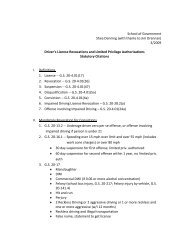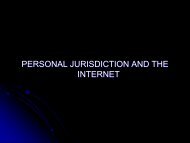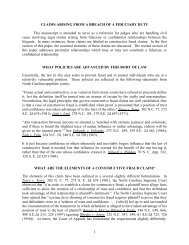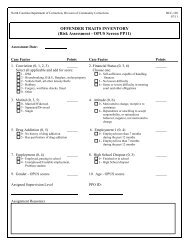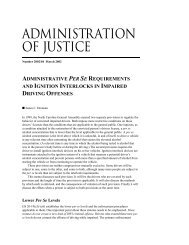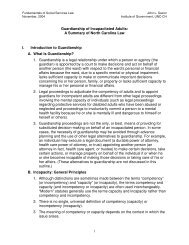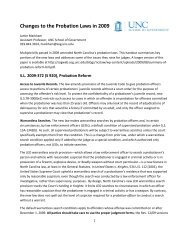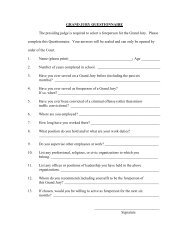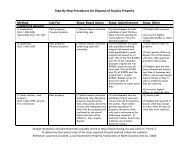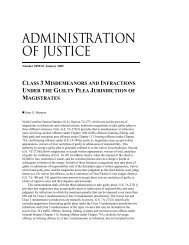Handout 1 - School of Government - University of North Carolina at ...
Handout 1 - School of Government - University of North Carolina at ...
Handout 1 - School of Government - University of North Carolina at ...
You also want an ePaper? Increase the reach of your titles
YUMPU automatically turns print PDFs into web optimized ePapers that Google loves.
Held: Reversed and remanded.<br />
1. The court <strong>of</strong> appeals rejected Mother’s argument th<strong>at</strong> the trial court’s 2002 finding th<strong>at</strong> F<strong>at</strong>her was the<br />
child’s biological f<strong>at</strong>her was not based on any pro<strong>of</strong> or proper legal proceeding for legitim<strong>at</strong>ion,<br />
because those issues were not addressed in the trial court or preserved for appeal.<br />
2. The court <strong>of</strong> appeals, however, agreed with Mother th<strong>at</strong> the trial court should have ordered a p<strong>at</strong>ernity<br />
test pursuant to G.S. 8-50.1, because<br />
a. F<strong>at</strong>her had never obtained a judgment <strong>of</strong> p<strong>at</strong>ernity;<br />
b. F<strong>at</strong>her had never acknowledged p<strong>at</strong>ernity by affidavit under G.S. 110-132(a); and<br />
c. “a question <strong>of</strong> parentage” arose when Mother contested F<strong>at</strong>her’s p<strong>at</strong>ernity.<br />
Dissent: Judge Jackson dissented from the second holding above on the basis th<strong>at</strong> p<strong>at</strong>ernity was judicially<br />
established by the 2002 court order and Mother neither appealed nor made a timely motion under G.S.<br />
1A-1, Rule 60(b), for relief from the judgment.<br />
Legitim<strong>at</strong>ion<br />
In re Pap<strong>at</strong>hanassiou, ___ N.C. App. ___, ___ S.E.2d ___ (2/3/09).<br />
http://www.aoc.st<strong>at</strong>e.nc.us/www/public/coa/opinions/2009/080095-1.htm<br />
Facts: Months after the child was born in 1998, respondent, who was married to the child’s mother,<br />
learned th<strong>at</strong> he was not the child’s biological f<strong>at</strong>her. He continued to act like the child’s f<strong>at</strong>her, however,<br />
and he and his wife had another child. The parents separ<strong>at</strong>ed in 2002 and were divorced the following<br />
year. In 2005, petitioner filed a special proceeding to legitim<strong>at</strong>e the child. After a hearing the clerk<br />
declared the child legitim<strong>at</strong>e, declared th<strong>at</strong> petitioner was the child’s f<strong>at</strong>her, and order th<strong>at</strong> the child’s birth<br />
certific<strong>at</strong>e be changed accordingly. Respondent appealed to superior court, de novo. Petitioner filed<br />
motions in limine asking th<strong>at</strong> respondent be prohibited from <strong>of</strong>fering “best interest” evidence and a<br />
motion for summary judgment. The court granted the motion for summary judgment and entered an order<br />
legitim<strong>at</strong>ing the child and directing th<strong>at</strong> the birth certific<strong>at</strong>e be changed. Respondent appealed, arguing<br />
th<strong>at</strong> summary judgment was not proper because, even though he admitted and a test showed th<strong>at</strong> he was<br />
not the child’s biological f<strong>at</strong>her, an issue <strong>of</strong> fact regarding the child’s best interest remained.<br />
Held: Affirmed.<br />
The court <strong>of</strong> appeals concluded th<strong>at</strong> the legisl<strong>at</strong>ure has not required a best interest determin<strong>at</strong>ion in a<br />
legitim<strong>at</strong>ion proceeding and th<strong>at</strong> the only issue for the court in such a proceeding is whether the petitioner<br />
is the child’s biological f<strong>at</strong>her. Therefore, summary judgment was proper. Other proceedings, the court<br />
said, provide vehicles for determining custody and other issues rel<strong>at</strong>ing to the child.<br />
Medicaid Reimbursement<br />
OTHER<br />
• <strong>North</strong> <strong>Carolina</strong>’s st<strong>at</strong>utory scheme for determining Medicaid reimbursements is reasonable and<br />
complies with federal law as interpreted by the U.S. Supreme Court.<br />
Andrews ex rel. Andrews v. Haygood, 362 N.C. 599, 669 S.E.2d 310 (12/12/08).<br />
http://www.aoc.st<strong>at</strong>e.nc.us/www/public/sc/opinions/2008/057-07-2.htm<br />
Facts: Minor plaintiff brought malpractice action seeking recovery for injuries she suffered <strong>at</strong> birth. The<br />
case was settled, and the Division <strong>of</strong> Medical Assistance (DMA) sought reimbursement from the<br />
settlement for the amount Medicaid had paid for the plaintiff’s medical expenses. The settlement did not<br />
specify wh<strong>at</strong> portion <strong>of</strong> the settlement amount was for medical expenses. The subrog<strong>at</strong>ion st<strong>at</strong>ute, G.S.<br />
108A-57, gives the st<strong>at</strong>e or county subrog<strong>at</strong>ion rights to all <strong>of</strong> a Medicaid recipient’s rights <strong>of</strong> recovery<br />
for medical expenses up to the amount paid by DMA but not exceeding one third <strong>of</strong> the judgment or<br />
17



